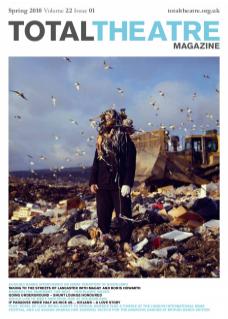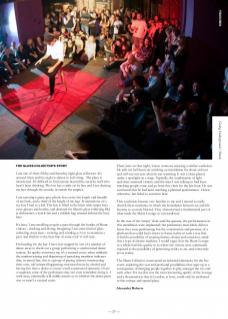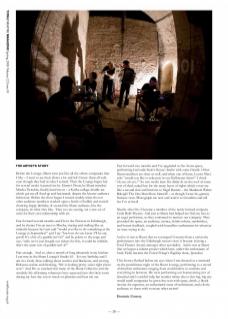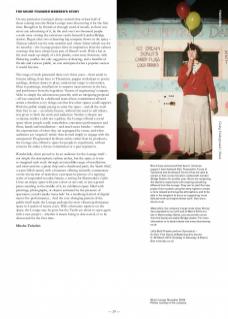The Visitor’s Story
A nondescript door opens onto a dark void. It is apparent such a thing has no business being in London Bridge Station. Some catch a fleeting, hazy, glimpse of something in the distance, unimaginable, almost certainly a mirage, but most don’t even break step. Those whose curiosity leads them on may well wonder if they’ve stumbled down a rabbit hole into some kind of fantasy world, a timeless place where rules of rationality and purpose no longer apply, a space like some kind of abandoned, industrial cathedral.
Inside, slightly dazed people wander about the dark recesses experiencing anything from theatre, trapeze, circus and freak shows to contemplative artworks, delightfully frivolous vanities, binaural book readings, music and noise, sometimes ridiculous, occasionally sublime.
It’s so much about space and context that listings are superfluous. People pay their meagre sum to be entertained, surprised, shocked or enlightened, but if whatever unfolds doesn’t grab their attention they are more than happy to head to the bar and drink. This freedom of expectation and movement allows Shunt to embrace the weird, the unmarketable, the uncategorisable, the unknown and is what stops it going stale and keeps people coming back.
Christopher Fraser
The Glass Collector’s Story
I am one of three Friday and Saturday night glass collectors. It’s around 12am and the night is almost in full swing. The place is intoxicated. It’s difficult to find anyone beyond the security staff who hasn’t been drinking. The bar has a smile on its face and I am dancing my feet through the crowds, in search for empties.
I am carrying a giant, grey plastic box, twice the length and breadth of my back, and a third of the height of my legs. It reminds me of a toy box I had as a kid. The box is filled to the brim with empty beer cans, glasses and bottles, and destined for Shunt’s glass collecting HQ (a dishwasher, a bottle bin and a rubbish bag situated behind the busy bar).
It’s busy. I am travelling at quite a pace through the hordes of Shunt visitors – ducking and diving, imagining I am some kind of glass collecting stunt man – twisting and winding as I try to maintain a pace and rhythm to the bass line of some rock ’n’ roll tune.
I’m heading for the bar. I have just stopped by one of a number of dance areas to check out a group performing a synchronised dance routine. Its quality convinces me it’s a curated event, when suddenly the random joining and dispersing of partaking members indicates that, in actual fact, this is a group of paying visitors; constructing their own, self-initiated happening; motivated more by alcohol and having fun than a desire to create a well-constructed spectacle. I have a suspicion some of the performers may not even remember doing it. I walk away, admittedly still mildly unsure as to whether the dance piece was or wasn’t a curated event.
Then, later on that night, I meet someone enjoying a similar confusion. He tells me he’d been sat watching an installation for about an hour and still was not sure what he was watching. It was a chair placed under a spotlight on a stage. Typically, the combination of light and chair attracted visitors, and the man I was talking to had been watching people come and go from this chair for the last hour. He was convinced that he had been watching a planned performance. I knew otherwise, but failed to convince him.
This confusion became very familiar to me and I started to really cherish these moments, in which the boundaries between art and life became so severely blurred. They characterised a fundamental part of what made the Shunt Lounge so extraordinary.
In the case of the ‘empty’ chair (and the queues), the performances in this installation were unplanned; the performers most likely did not know they were performing; but the construction and presence of a platform that could lead visitors to frame reality in such a way that it had the possibility of creating fantasy, drama and narratives, made this a type of theatre machine. I would argue that the Shunt Lounge as a whole had this quality to it; where the visitors were continually exposed to the possibility of perceiving reality as art, and conversely art as reality.
The Shunt Collective constructed an informal laboratory for the live event, exploring the vast and profound possibilities that open up as a consequence of bringing people together to play amongst the art, and each other. For me this was the most interesting quality of the Lounge, and a characteristic that in London, at least, could only be attributed to this unique and special place.
Alexander Roberts
The Artist’s Story
Before the Lounge, Shunt were just like all the others companies that I like – I went to see their shows a lot and felt I knew them all well, even though they had no idea I existed. Then the Lounge began but for several weeks it passed me by. Klamm’s Dream, by Shunt member Mischa Twitchin, finally lured me in – a Kafka-collage double-act which got me all fired up and fascinated, despite the bizarre audience behaviour. Before the show began I sensed trouble when the ten other audience members cracked open a bottle of bubbly and started chanting happy birthday. It seemed the Shunt audience, like the company, do what they like. They too are sussing out a new set of rules for their own relationship with art.
Fast forward several months and I’m in the Traverse in Edinburgh, and by chance I’m sat next to Mischa, staring and smiling like an imbecile because he’s just said “would you like to do something at the Lounge in September?” and I say “but how do you know I’ll be any good? It’s a bit of a gamble isn’t it?” and he points to the stage and says “well, we’ve just bought our tickets for this, it could be rubbish; that’s the same sort of gamble isn’t it?”
Fair enough. And so, after a month of long rehearsals in my kitchen I am now in the Shunt Lounge’s Studio 65. It is my birthday and I am in a lovely dress talking about worries and blackouts, and serving Belizean cuisine and thinking, “life is looking pretty sweet right about now”. And I’m so touched that many of the Shunt Collective and the similarly life-affirming volunteers have squeezed into this little room during my four day run to snack on plantain and hear me out.
Fast forward two months and I’ve upgraded to the Arena space, performing Gertrude Stein’s Reread Another with some friends. Other Shunt members are there as well, and when one of them, Louise Mari, asks “would you like to take part in our Halloween show?” I think “oh yes, oh yes..!” So two weeks later I’m dimly lit on the roof of some sort of shed, naked but for the many layers of tights which cover me like a second skin and bind me to Nigel Barrett – the Mudman! Walter Raleigh! The One Man Show himself! – as though I were his gammy Siamese twin. Photograph me now and send it to Grandma and tell her I’ve arrived!
Shortly after this I became a member of the newly formed company Little Bulb Theatre. And just as Shunt had helped me find my feet as an eager performer, so they continued to nurture our company. They provided the space, an audience, money, drinks tokens, sandwiches, and honest feedback, coupled with boundless enthusiasm for whatever we were trying to do.
And so it was at Shunt that we revamped Crocosmia from a university performance into the Edinburgh success story it became (wining a Total Theatre Award, amongst other accolades). And it was at Shunt that we began a cabaret project which later, under the enthusiasm of Andy Field, became the Forest Fringe’s flagship show, Sporadical.
This history flashed before my eyes when I was dressed as a mermaid on the penultimate night of the Shunt Lounge, performing to a crowd of drunken enthusiasts ranging from stockbrokers to students and everything in between. We were performing our homecoming run of Sporadical and I couldn’t help but wonder where else in this big, big city would small companies be given free rein with space, drink, a blank invoice for expenses, an enthusiastic team of technicians, and a lively audience, to share with so many other artists?
Dominic Conway
The Shunt Founder Member’s Story
On any particular evening it always seemed that at least half of those coming into the Shunt Lounge were discovering it for the first time. Brought in by friends or through word of mouth, as there was never any advertising of it, by the end over two thousand people a week were visiting the cavernous vaults beneath London Bridge station. Begun after two exhausting big company shows in the space – Tropicana (which ran for nine months) and Amato Saltone (which ran for six months) – the Lounge project drew its inspiration from the cabaret evenings that have always been part of Shunt’s work. With a bar at the start made up simply of a few planks, some stray furniture, with flickering candles the only suggestion of dancing, and a handful of friends and curious public, no one anticipated what a popular success it would become.
The range of work presented there over three years – from aerial to fortune telling, from lutes to Theremins, puppet workshops to poetry readings, abstract dance to plays, underwater tango to electronica, films to paintings, installations to surprise interventions in the bar, and performers from the legendary ‘theatre of engineering’ company Akhe to simply the adventurous passerby with an intriguing proposal – all was sustained by a dedicated team whose commitment allowed artists a freedom to try things out that few other spaces could support. With the public simply paying to enter the space – and all the work then free to see – an artistic licence, without the need to sell tickets, was given to both the work and audiences. Neither a theatre nor a cinema, neither a club nor a gallery, the Lounge offered a social space where people could, nonetheless, encounter performances and films, bands and installations – and much more besides – without the expectations of when they are segregated by venue, and when audiences are ‘targeted’, rather than invited simply to engage with the unexpected. Programmed by Shunt artists rather than by producers, the Lounge also offered a space for people to experiment, without concern for either a future commission or a past reputation.
Wonderfully, there proved to be an audience for the Lounge itself – not simply the atmospheric railway arches, but the space as it was re-imagined each week through an incredible range of installations and interventions: a pirate ship and a skateboard park; the ‘death slide’; a water-filled tunnel, with a boatman offering scientific commentary on the interaction of neutrinos; a perspective picture of a tapering series of suspended wooden frames; a setting for Sharmanka’s Gothic Circus; an empty space with just a door at one end, or just a grand piano standing in the middle of it; an exhibition space filled with paintings, photographs, or objects animated by the presence of spectators; a multi-media ‘meta-hub’ for a week-long festival of digital-meets-live performances... And the ever-changing pattern of the public itself made the Lounge perhaps the most vibrant performance space in London of recent years. With a fortunate reprieve on the space, the Lounge may be gone but the Vaults are about to open again with a new project – whether it means being re-discovered, or to be discovered for the first time.
Mischa Twitchin
Shunt have announced that due to ‘immense support’ from Network Rail, Thameslink, Turner & Townsend and Southwark Council they are able to remain in their current location underneath London Bridge Station for another year. Shunt are reopening the Vaults to experiment with creating something different from the Lounge. They aim to start this new project from scratch using the early nights to create a more relaxed and snug-like atmosphere, and to be able in the longterm to focus on supporting ‘more delicate work and experimental work’. See www. shunt.co.uk
Meanwhile, the company’s large-scale show Money has extended its run until end of March 2010 at a site in Bermondsey Street, just around the corner from the Vaults at London Bridge station. For more information or to book tickets visit www.shuntmoney. co.uk
Little Bulb Theatre perform Sporadical – An Epic Folk Opera at Battersea Arts Centre 2–20 March 2010 (Tuesday to Saturday, 9.30pm). See www.bac.co.uk




